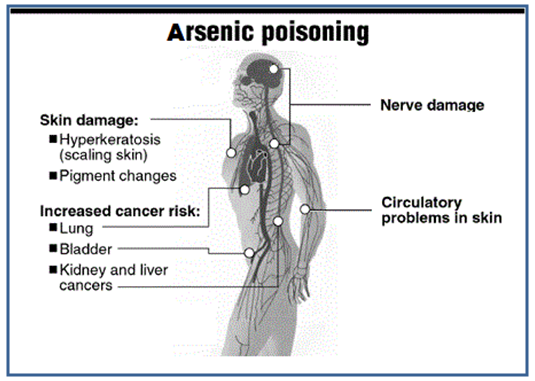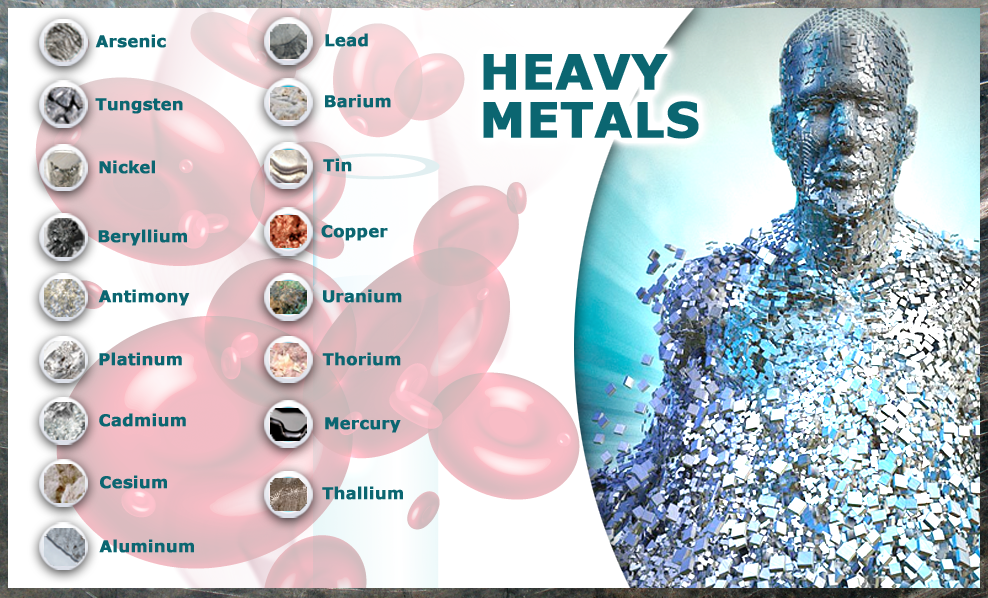Symptoms of Arsenic Poisoning in Water

What are the Symptoms of Arsenic in Water? If you’re worried about this, you’re not alone. One of my jobs as a Holistic Doctor is to help patients understand the risks of heavy metal poisoning and how to get tested for it.
Arsenic is one of the most common culprits of heavy metal poisoning. Arsenic poisoning can lead to cancer, liver disease, coma, and eventually death. Shocking new research from the US Geological Survey (USGS) is revealing that the prolonged droughts happening in parts of the US could mean danger for people who rely on well water.
In this article, we’ll talk about this trend and cover some of the symptoms of arsenic in water. We’ll also touch on some methods for testing your arsenic levels and other heavy metals.
Bioaccumulation is the concentration of toxic substances by an organism over an extended period of time. This occurs in all species, and is magnified progressively up the food chain.
Toxic elements we consume in liquids and foods, breathe in from the air or absorb through our skin are retained in the body for different durations, depending on their chemical properties. The amount of time it takes for the body to eliminate half of a specific substance is called its half-life.
Toxic heavy metals such as aresenic, cadmium, mercury, and lead can accumulate over a lifetime and have long half-lives in different organs and tissues.

Common symptoms of acute arsenic toxicity include:
- Breathing problems
- Nausea, diarrhea, vomiting
- Death if exposed to high levels
- Decreased intelligence
- Known carcinogen: lung and skin cancer
- Peripheral nervous system problems
These symptoms can be the result of acute arsenic poisoning or chronic arsenic poisoning. Acute arsenic poisoning is when you get a high-level dose of arsenic in a short period of time and have a noticeable reaction.
Chronic arsenic toxicity is when low levels of arsenic accumulate in your system over time. The way your body eliminates arsenic depends on the type of metal (organic or inorganic). However, like many toxins, small doses of arsenic can build up to dangerous levels, and this can happen faster than your body can eliminate it. The following is a statement from the Government of Western Australia’s Department of Mines, Industry Regulation and Safety…
Symptoms of low level chronic Arsenic exposure can be varied.
Recent research is investigating Arsenic’s role in Type 2 Diabetes.
Studies have connected high Arsenic levels in the body with skin blemishes, especially seborrheic keratoses.
Fatigue can be a result due to the kidney’s inability to clear toxins thoroughly. As the kidney as an energetic organ maintains the overall level of Chi, or Life Force, this can drain your health quickly.
“Inorganic arsenic is rapidly excreted via the kidneys, of which 10-20% is excreted unchanged, 10-20% as MMA and 60-80% as DMA. Excretion commences within the first few hours after exposure. Most of the arsenic is excreted in the urine within three days (half-life of one to two days). However, it may take weeks to completely eliminate a single dose.”
Chronic toxicity happens when your body can’t eliminate a toxin fast enough through the kidneys. Since it takes weeks to eliminate a single dose of arsenic, we can understand how even subtle exposure over time can lead to the symptoms mentioned above. Chronic arsenic poisoning may start to present as numbness, abdominal pain, vomiting, encephalopathy (a type of brain dysfunction), bloody and/or watery diarrhea, darkening or thickening of the skin, heart disease, and even cancer.
Inorganic arsenic is found in industrial materials including treated lumber and copper and was once used in certain paint pigments and pesticides. However, inorganic arsenic compounds are more frequently found in groundwater and especially private wellwater, sediments, and soils. This is sometimes the result of mining, ore smelting, or nearby industrial use of inorganic arsenic found in fertilizers and pesticides.
Types of Arsenic and Arsenic Exposure
To fully understand the symptoms of arsenic in water, we need to know how arsenic ends up in our water supply.
While today’s laws restrict using arsenic-containing pesticides, wood preservatives, and medicines, there is still plenty of arsenic in our environment as a result of past use and present use.
It can even end up in some “organic” products due to its presence in the soil.

A study published in the Fourth National Report on Human Exposure to Environmental Chemicals (Fourth Report), explained how scientists at the CDC found seven different species of arsenic in the urine of 2,557 participants six years of age or older. The scientists estimated that the arsenic had entered these participant’s system within two or three days of the time of their study.
How Droughts Increase Symptoms of Arsenic in Water
More than half of the continental United States is suffering some kind of drought, with about a quarter experiencing severe droughts due to a reduction in snow and/or rainfall. Such droughts can cause crop failures, wildfires, and water shortages.
However, a more recent development is how these droughts might be effecting the quality of our water and therefore our health. According to research from the US Geological Survey (USGS), these droughts could increase the risk of harmful arsenic exposure for people who rely on well water for drinking.

This is because of arsenic, which is a common groundwater contaminant. For example, in Maine, the Appalachian Mountains formed as a result of volcanic activity coming together. This caused high concentrations of arsenic to accumulate inside craks in the bedrock. From there, subtle shifts in water flow rates, acidity, and temperature, contaminants (like arsenic) moved from these areas of bedrock and into underground aquifers.
The same thing happened in other places in New England, in the Midwest, and in the Southwest Continental United States. These made higher than normal arsenic levels to become common within the aquifers in these areas. Private wells are created by drilling down into these aquifers to tap the natural water supply, and this is how well water can be contaminated without homeowners knowing it.
Unlike municipal water supplies, private wells are not treated for contaminants like arsenic. They aren’t subject to federal regulations and protections. They’re not routinely monitored, tested, and treated for such contanimants. The wellowner is soley responsible for the integrity of their wellwater. According to a 2017 estimate from the US Geological Survey (USGS) between 1.5 and 2.9 million people in the US are drinking from wells that have arsenic concentrations above the federal limit of 10 parts per billion. They also predicted that this number would increase by 2021.
Droughts cause a decrease in groundwater levels. Since the amount of metals and other chemicals in the bedrock do not change, this leads to higher concentrations of these contaminants in the remaining groundwater. In other words, the drought doesn’t cause higher levels of arsenic and other heavy metals. It simply raises their concentrations by lowering the water levels.
Since arsenic is colorless, odorless, and tasteless, the people drinking this water are unlikely to notice a difference. However, after enough time, the symptoms of arsenic in water start to show up. On top of the symptoms mentioned above, scientific research with fish and mice has revealed that arsenic exposure might permanently alter gene expression and DNA through epigenetic changes. Thankfully, there are ways to detect these symptoms of arsenic in water and protect yourself from their long term impact.
Preventing Symptoms of Arsenic Toxicity
According to Bruce Stanton, a molecular physiologist at the Geisel School of Medicine at Dartmouth in New Hampshire, water filtration systems can help to protect people from the symptoms of arsenic in water. However, it’s also important to understand that arsenic can get into your system in many other ways.
In fact, beauty products routinely hide arsenic under alternative names, including: Arsenite, Atomic Number 33, Fowler’s Solution, Numéro Atomique 33, Solution de Fowler, just to name a few.

According to the survey by the FDA heavy metals like arsenic, cadmium, chromium, cobalt, lead, mercury, and nickel were found present (in unsafe amounts) both luxury and budget brand beauty products. Even organic beauty products and those made with “natural” ingredients (clays etc.) can contain heavy metals these heavy metals. According to the CDC arsenic fact sheet, people can be exposed to inorganic arsenic by eating foods like rice and even some fruit juices.
Thankfully, you can get tested for arsenic and other heavy metals and toxins and start a detox program. There are several ways to test for heavy metals and other toxins. I prefer the Heavy Metal test from ZRT Labs, because they give values that can indicate if the exposure was recent or chronic over longer periods of time.
I hope you enjoyed this article on the symptoms of arsenic in water and other sources.
If you want to get more Holistic Health news updates and in depth articles like this one, click here to subscribe to my newsletter.
Are you experiencing any of the symptoms mentioned in this article? Are you someone who drinks private well water and is concerned about arsenic or other contaminants? If so, I can help.

I’ve helped a lot of people understand the complicated risk factors and symptoms of heavy metal toxicity and reset their health. The first step is having a thorough toxicty test conducted by an experienced doctor.
A good Heavy Metal Detox program (which is different than a cleanse) can give you more energy, greater mental focus, and empower you to feel better than you have in years. As a holistic doctor, it’s my job to look at the body as an entire system, instead of just treating for symptoms. Patients come to me for help with fatigue, headaches, chronic pain, sleep disorders, immune system problems, general anxiety, GI issues and much more.
Are you read to feel better than you’ve felt in years? Do you want more energy, more mental focus, and more confidence in your overall health and wellness? Pick from one of the options below and let’s get started. Together, we’ll troubleshoot the complex causes of your symptoms and help you get clarity so you can start feeling better.

About The Author
Dr. Robin Mayfield is a Holistic Doctor in Austin, Texas. She was educated at Texas A&M University and has been practicing since 1991.
Her work has been published in the Texas Journal of Chiropractic and Women’s Networking Magazine in Austin, TX, featured in New Perspectives on Women’s Health, Austin Magazine and in the published book 5 Steps to Selecting the Best Alternative Medicine: A Guide to Complementary & Integrative Health Care.
Dr. Mayfield has also been a featured speaker on local Austin Television KVUE Sunday Morning News and at Systemic Formulas Women’s Health Symposium and has been interviewed and quoted for articles published in the Canyon Courier, Evergreen, CO and Good Life National Magazine.
Now What? Take your Next Step to Better Health!
*Schedule a Free Consult to find out if you are a good candidate for Natural Health Care.
*Schedule a Free Consult to find out if you are a good candidate for Natural Health Care.

